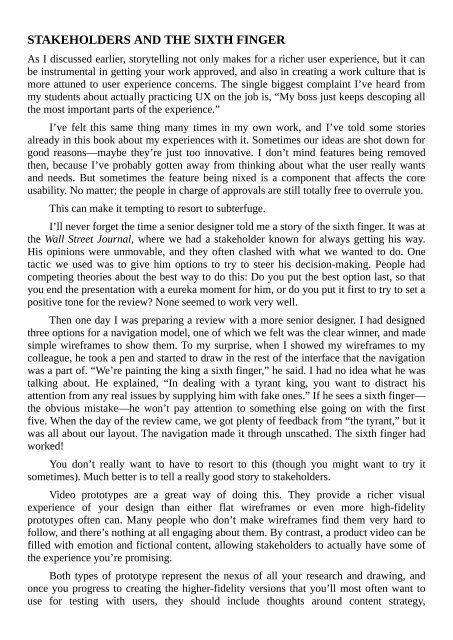Create successful ePaper yourself
Turn your PDF publications into a flip-book with our unique Google optimized e-Paper software.
STAKEHOLDERS AND THE SIXTH FINGER<br />
As I discussed earlier, storytelling not only makes for a richer user experience, but it can<br />
be instrumental in getting your work approved, and also in creating a work culture that is<br />
more attuned to user experience concerns. The single biggest complaint I’ve heard from<br />
my students about actually practicing UX on the job is, “My boss just keeps descoping all<br />
the most important parts of the experience.”<br />
I’ve felt this same thing many times in my own work, and I’ve told some stories<br />
already in this book about my experiences with it. Sometimes our ideas are shot down for<br />
good reasons—maybe they’re just too innovative. I don’t mind features being removed<br />
then, because I’ve probably gotten away from thinking about what the user really wants<br />
and needs. But sometimes the feature being nixed is a component that affects the core<br />
usability. No matter; the people in charge of approvals are still totally free to overrule you.<br />
This can make it tempting to resort to subterfuge.<br />
I’ll never forget the time a senior designer told me a story of the sixth finger. It was at<br />
the Wall Street Journal, where we had a stakeholder known for always getting his way.<br />
His opinions were unmovable, and they often clashed with what we wanted to do. One<br />
tactic we used was to give him options to try to steer his decision-making. People had<br />
competing theories about the best way to do this: Do you put the best option last, so that<br />
you end the presentation with a eureka moment for him, or do you put it first to try to set a<br />
positive tone for the review? None seemed to work very well.<br />
Then one day I was preparing a review with a more senior designer. I had designed<br />
three options for a navigation model, one of which we felt was the clear winner, and made<br />
simple wireframes to show them. To my surprise, when I showed my wireframes to my<br />
colleague, he took a pen and started to draw in the rest of the interface that the navigation<br />
was a part of. “We’re painting the king a sixth finger,” he said. I had no idea what he was<br />
talking about. He explained, “In dealing with a tyrant king, you want to distract his<br />
attention from any real issues by supplying him with fake ones.” If he sees a sixth finger—<br />
the obvious mistake—he won’t pay attention to something else going on with the first<br />
five. When the day of the review came, we got plenty of feedback from “the tyrant,” but it<br />
was all about our layout. The navigation made it through unscathed. The sixth finger had<br />
worked!<br />
You don’t really want to have to resort to this (though you might want to try it<br />
sometimes). Much better is to tell a really good story to stakeholders.<br />
Video prototypes are a great way of doing this. They provide a richer visual<br />
experience of your design than either flat wireframes or even more high-fidelity<br />
prototypes often can. Many people who don’t make wireframes find them very hard to<br />
follow, and there’s nothing at all engaging about them. By contrast, a product video can be<br />
filled with emotion and fictional content, allowing stakeholders to actually have some of<br />
the experience you’re promising.<br />
Both types of prototype represent the nexus of all your research and drawing, and<br />
once you progress to creating the higher-fidelity versions that you’ll most often want to<br />
use for testing with users, they should include thoughts around content strategy,


